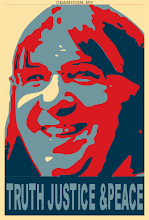A Work of Art

Yet another Eakins post.
It was this query from Attytood that got me thinking:
How come these rich donors rarely come out of the woodwork so quickly for any cause that involves education, or crime reduction? Just asking....A good question. Admittedly, I have been fairly vocal as an opponent of Jefferson's decision to sell the Eakin's The Gross Clinic to Art-Mart (otherwise known as Alice Walton).* See here, here, here and here.
One of my major objections is that this masterpiece should not leave Philly and the price of keeping it here is obscenely high, inflated by the obscene wealth of Walmart money, Values and The Gross Clinic. Jefferson had to take the easy way out to raise money for its expansion? How lazy is that?
There are so many other projects that warrant the time, effort & money that are now being diverted to try to save the painting that belongs in Philly, Eakins fund drive obscures others. And the depletion of scarce resources is not only in the cultural area, but education and other social services that will not receive this money.
Sister Mary Scullion explores this aspect of the issue, in What not to sacrifice for art: Care:
The civic uproar over the pending sale of Thomas Eakins' The Gross Clinic for $68 million raises complex questions about our society's priorities and values.See also, Where’s the money?.
The passion over where this painting goes is certainly understandable, but also a bit unsettling when so many Philadelphians cannot afford a home and when the loss of a child's life due to violence is barely noticed.
While we must affirm the importance of the arts in our community, we citizens must be mindful of human needs. . . . Today's issues, such as health care, homelessness, poverty and social services, are becoming distressingly low in our priority list.
Each day in our city, many people do without the basic necessities for themselves and their families. We are witnessing an alarming increase in the rate of poverty (currently at 25 percent), while the number of homeless people on our streets and in shelters is on the rise. Gun violence is rampant, claiming victims daily. And we face a serious crisis in public health. Tens of thousands of Philadelphians who are low-income, uninsured or aging struggle to get basic health care - and the numbers are growing.* * * *The controversy over this painting should not pit the arts against human needs. Rather, the best outcome is for Eakins' masterpiece to remain in Philadelphia, and for its presence to enlighten us to the necessity of investing in health care with an emphasis on those who are left behind.
More than a work of art is at stake. If we rise to the challenge of keeping The Gross Clinic in our city, yet fail to address serious issues such as health care, homelessness, poverty and social services, we will miss an opportunity to live out the values expressed by Eakins. Rather than being enriched by our struggle to retain a beloved work of art, we will be diminished by our failure to include the poor and the vulnerable in our vision for this city.
Of course, Attytood and Sister Scullion are absolutely correct. The educational system, for example, in Philly is atrocious. And crime? The level of violence in the streets of Philadelphia makes my heart cry. So why is there more passion exerted to save a painting than for other issues that are so compelling? I think it is because these other problems are so complex, so overwhelming that there is a sense that one can't make any impact in fixing them. How do you begin to fix the problems that plague the inner city schools? I don't have a clue.
On the other hand, the Eakins painting is a discrete issue that can be focused on and the solution is simple. Jefferson betrayed its alumni and the city by selling the painting, but it can be saved by raising a certain amount of money. Easy to complain about, not so easy to fix ($68 million in 45 days is daunting) -- but not impossible.
And what's more, all of the uproar has gotten results. The Inquirer reports, Jefferson plans to set up Eakins Legacy Fund:
Thomas Jefferson University officials have determined that proceeds from the controversial sale of Thomas Eakins' The Gross Clinic should be used to establish a permanent fund for scholarships and endowed faculty positions.So the public outcry has embarrassed Jefferson enough to at least make it do something good with the money it receives from the sale. And the public (or some extremely rich people in the community) have raised at least one-third of the money in 20 days. How much more has been raised since then is unknown, 18 Days: It's Bloody Time to Hear.
In an e-mail sent to the university community Friday, Jefferson president Robert Barchi said the record $68 million sale would create the Eakins Legacy Fund. The "corpus of this fund will never be spent," he wrote, and half the income generated would be regularly used for scholarships and endowed professorships.
The rest of the income, according to the e-mail, "will be used to support other key initiatives in the strategic plan, ranging from new faculty recruitment to classroom and laboratory renovations for new programs."
For more on the Eakins, see "Presidents And CEO’s Are Allowed To Have Bad Ideas Too" and What were they thinking?.
* I must admit, if the circumstances were different, I might actually admire Alice Walton. This piece about her, Despite royalty, a loyalty to roots, from the Centre Daily, portrays her as a maverick, as someone I would ordinarily like.
(Cartoon by Richard Anderson, from the Chestnut Hill Local)
Tags:

No comments:
Post a Comment